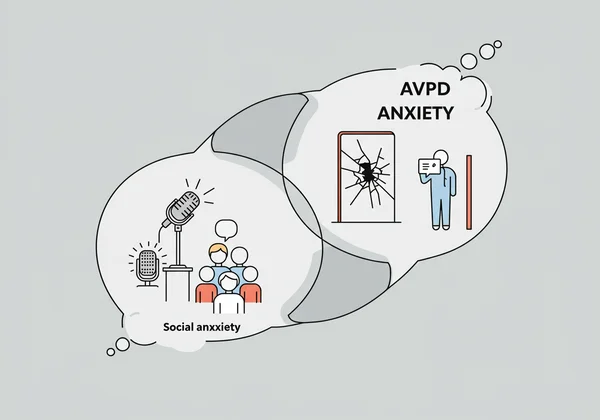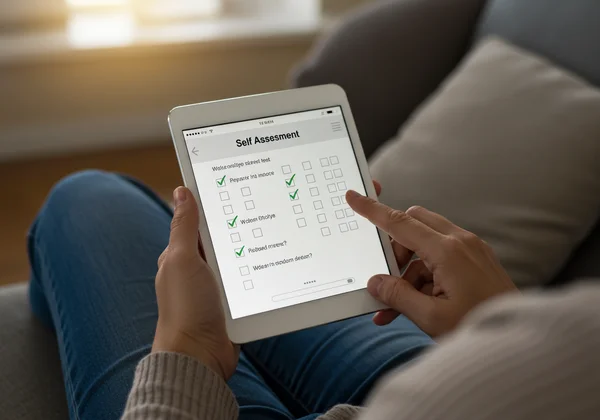AVPD Test: Social Anxiety vs. Avoidant Personality Explained
Feeling overwhelmed by social situations? You’re not alone. Many people confuse everyday shyness, social anxiety, and a more profound condition called Avoidant Personality Disorder. It's easy to feel lost when trying to understand your own experiences, especially when symptoms seem to overlap. This guide will help untangle the crucial differences, offering you a clearer understanding of your experiences and where to find insights. We'll delve into these conditions, highlighting their key characteristics, and explain how a confidential AVPD test can provide a valuable starting point. Do I have social anxiety or AVPD? Let's find out together.
Understanding Social Anxiety Disorder (SAD)
Social anxiety disorder, also known as social phobia, is a common mental health condition. It involves an intense, persistent fear of social situations, driven by the dread of being judged, scrutinized, or humiliated by others. This fear can be so overwhelming that it interferes with daily life, making simple interactions feel impossible.
What Are the Core Symptoms of Social Anxiety?
The core symptoms of social anxiety revolve around a fear of performance or negative evaluation in specific social settings. Common symptoms include:
- Intense worry before, during, and after social situations.
- Physical symptoms like blushing, sweating, trembling, or a racing heart.
- Avoiding social gatherings, public speaking, or even eating in front of others.
- Fear of being watched or criticized.
- Difficulty making eye contact or engaging in conversation.
These fears are often triggered by specific social contexts rather than a constant, pervasive sense of inadequacy.

When Is Social Discomfort More Than Just Shyness?
Everyone experiences a degree of shyness now and then. It’s a common human trait characterized by feelings of apprehension or discomfort in social situations. However, social discomfort becomes social anxiety when it is pervasive, causes significant distress, and interferes with your life. While shyness might make you feel a bit awkward, social anxiety can lead to a complete avoidance of situations that are crucial for work, school, or personal relationships. It's not just a preference for quiet; it's a profound fear.
Delving into Avoidant Personality Disorder (AVPD) Traits
Avoidant Personality Disorder (AVPD) is a more ingrained and pervasive condition than social anxiety. It's characterized by a deep-seated pattern of social inhibition, feelings of inadequacy, and extreme sensitivity to negative evaluation. Individuals with AVPD often avoid social interaction not just out of fear of embarrassment, but because they believe they are inherently unlikable or inferior.
Key Characteristics and Underlying Fears in AVPD
The avoidant personality traits extend beyond mere social fear. Individuals with AVPD harbor deep feelings of inadequacy and worthlessness. Their underlying fear is not just of negative judgment, but of being exposed as flawed or inept. Key characteristics include:
- Pervasive feelings of inadequacy.
- Hypersensitivity to criticism or rejection.
- Extreme self-consciousness in social settings.
- Reluctance to get involved with others unless certain of being liked.
- Preoccupation with being criticized or rejected in social situations.
- Restraint within intimate relationships due to fear of shame or ridicule.
- Viewing oneself as socially inept, personally unappealing, or inferior to others.
These signs of AVPD paint a picture of someone who genuinely desires connection but is paralyzed by their intense fear of rejection.

The Pervasive Nature of Avoidance in Daily Life
The pervasive avoidance seen in AVPD is a defining characteristic. Unlike social anxiety, which might be situational, AVPD affects nearly all aspects of a person's life. It impacts career choices, friendships, and romantic relationships. People with AVPD may avoid new opportunities, professional advancements, or even casual social outings, not because they dislike them, but because the risk of criticism or rejection feels too great. This consistent pattern of withdrawal contributes to significant loneliness, despite a strong internal longing for connection.
Social Anxiety vs. AVPD: Crucial Distinctions
It's crucial to understand the subtle differences between these two conditions. While they share overlapping symptoms, their underlying motivations and the pervasive nature of their impact are distinct. Here's a breakdown of the avpd differences:
The Scope of Distress: Situational vs. Identity-Level
For someone with social anxiety, the distress is often situational. They might feel intense fear before a presentation or a party, but once the situation passes, the anxiety subsides. Their fear is of specific situations or performances. In contrast, individuals with AVPD experience identity-level distress. Their fear is rooted in a fundamental belief that they are unworthy or fundamentally flawed. This belief colors every interaction and informs their very sense of self, making the avoidance constant and deeply ingrained.
Desire for Connection: Longing vs. Performance Anxiety
This is perhaps one of the most critical differentiators. People with social anxiety often want to engage socially but are held back by performance anxiety – the fear of doing something embarrassing or being negatively evaluated. They desire connections but fear the process. Individuals with AVPD, however, have a profound longing for connection. They deeply crave relationships and intimacy but are so terrified of being rejected or criticized that they consistently avoid opportunities for closeness. Their desire is thwarted by their overwhelming fear of vulnerability.
Stability Over Time: Persistent Patterns vs. Contextual Reactions
Social anxiety can fluctuate in intensity and may be more prominent in certain periods or contexts. It often responds well to targeted therapeutic interventions. AVPD, however, demonstrates persistent patterns of behavior and self-perception that are stable over time and across different situations. It is a personality disorder, meaning it's a deeply ingrained way of thinking, feeling, and behaving that typically emerges in early adulthood and affects multiple areas of life. It is not just a reaction to a specific context, but a consistent way of navigating the world.

How to Tell Which Might Apply to You
Sorting through these distinctions can feel challenging, but pausing to reflect on your own patterns is a powerful first step. Understanding your patterns and underlying feelings can provide valuable clarity.
Self-Assessment Questions: A Starting Point for Clarity
To begin your avpd selfassessment, consider these questions honestly:
- Do I avoid social situations primarily because I fear embarrassment or making a mistake, or because I feel fundamentally unlikable or inferior?
- Do I intensely desire close relationships, even though I struggle to form them due to fear of rejection?
- Are my fears about social interactions consistent across almost all areas of my life (work, school, friendships, romance), or are they more specific to certain scenarios?
- Have these feelings of inadequacy and hypersensitivity been a long-standing pattern in my life, dating back to adolescence or early adulthood?
- Would I rather be alone, even if it makes me lonely, than risk exposing myself to potential criticism or judgment?
Why a Confidential Online AVPD Test Can Help
If these questions resonate with you, an online AVPD test can be an incredibly helpful tool. It's designed to provide a preliminary avpd screening tool based on established psychological criteria (like the DSM5). It’s not a diagnostic tool, but it can help you identify potential traits and give you a framework for understanding your experiences. Taking a free AVPD test in a private, anonymous setting can empower you to explore these sensitive issues without fear of judgment. You can gain instant insights and begin your journey towards self-understanding. To get started, you can easily discover your results through a confidential online assessment.

Your Path to Clarity: Taking the Next Steps
Understanding whether your struggles align more with social anxiety or avoidant personality traits is a significant step toward gaining clarity. While this article provides valuable information, it's essential to remember that online resources are for educational purposes only and cannot provide a formal diagnosis.
If you suspect you might be experiencing symptoms of either social anxiety or AVPD, taking a free, confidential online assessment can offer immediate insights into potential traits. This can be a vital first step in your journey toward self-understanding and well-being.
Ready to gain more clarity? Take the next step today. Visit the official website to start your assessment and explore personalized insights into your experience. Remember, seeking to understand yourself is a truly courageous act, and you deserve that clarity.
Frequently Asked Questions About Social Anxiety & AVPD
Is avoidant personality disorder the same as being shy?
No, avoidant personality disorder is not the same as being shy. Shyness is a common personality trait characterized by occasional discomfort in social situations. AVPD, however, is a pervasive and severe mental health condition involving intense feelings of inadequacy, extreme sensitivity to criticism, and a deep-seated pattern of avoiding social interaction due to fear of rejection. While both involve social discomfort, AVPD is far more debilitating and long-lasting, often leading to significant distress and impairment in daily functioning.
Do I have social anxiety or AVPD?
Distinguishing between social anxiety and AVPD often comes down to the pervasiveness of the avoidance and the underlying motivation. If your fear is primarily linked to specific social situations and the worry of being judged or embarrassed, it might be social anxiety. If your avoidance stems from a deep, enduring belief that you are inherently inadequate, unlikable, or inferior, and you desperately desire social connection but are paralyzed by the fear of rejection across most areas of your life, it could align more with AVPD. A confidential free test can help you gain initial insights based on your experiences.
Can an online test truly help me differentiate these conditions?
An online avpd quiz or self-assessment tool, like the one based on DSM5 standards, can provide a valuable preliminary screening for potential traits of AVPD. It offers a structured way to reflect on your symptoms and compare them to recognized criteria in a private and non-judgmental environment. While these tests are not diagnostic tools, they are designed to help you identify patterns and provide a clearer understanding of your experiences. This initial insight can then empower you to decide if you want to explore professional support or resources. You can try our free tool today and take a step towards greater self-awareness.